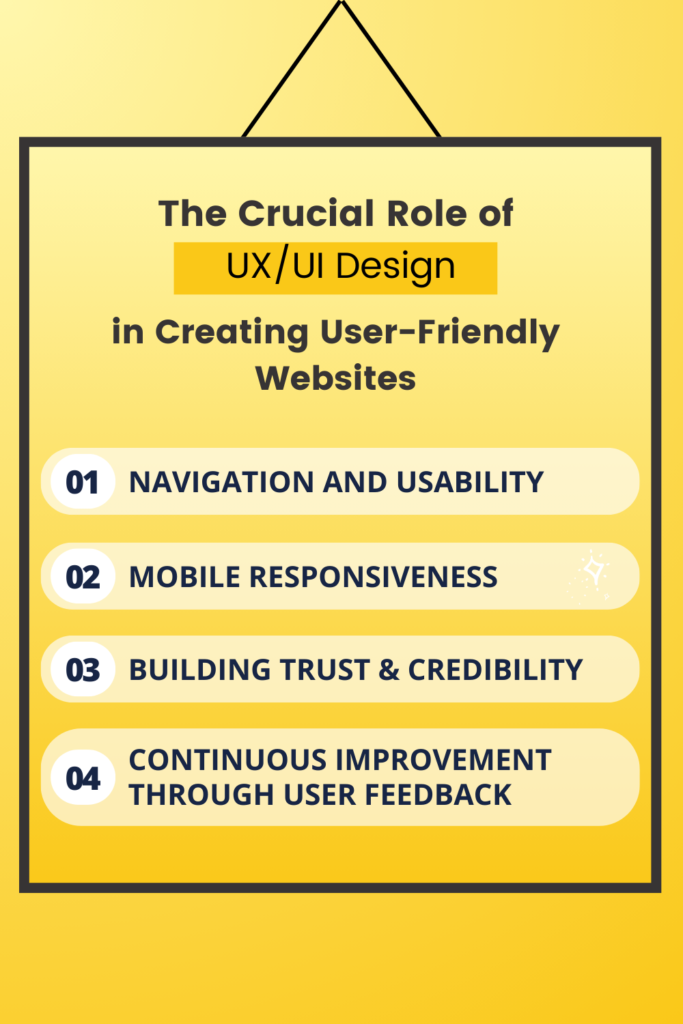In the ever-evolving digital landscape, the success of a website hinges on more than just its content. The user experience (UX) and user interface (UI) design play pivotal roles in ensuring that visitors not only find what they’re looking for but also enjoy a seamless and intuitive journey through the site. In this blog post, we’ll delve into the significance of UX/UI design and how it contributes to the creation of user-friendly websites.
Table of Contents
Understanding UX and UI Design
User Experience (UX):
UX design focuses on enhancing the overall experience a user has while interacting with a website. It encompasses factors such as navigation, accessibility, content structure, and overall usability. A well-thought-out UX design aims to make the user’s journey smooth and enjoyable, ultimately leading to increased user satisfaction and engagement.
User Interface (UI):
UI design, on the other hand, is concerned with the visual elements of a website—the look and feel. It involves the design of buttons, menus, forms, and other interactive elements that users interact with directly. A well-designed UI not only enhances the aesthetics of a website but also contributes to a more intuitive and user-friendly experience.

The Impact on First Impressions
First impressions matter, especially in the digital realm. Users often form an opinion about a website within the first few seconds of visiting it. A visually appealing and well-organized UI, coupled with an intuitive UX, can captivate users and encourage them to explore further. On the contrary, a confusing layout or a lackluster design may drive users away.
Navigation and Usability
Effective navigation is a cornerstone of good UX/UI design. Users should be able to easily find what they are looking for without feeling lost or frustrated. Clear and concise menus, logical page structures, and intuitive navigation paths contribute to a positive user experience. Prioritizing usability ensures that visitors can seamlessly interact with the website, leading to higher user retention and engagement.
Mobile Responsiveness
With the increasing use of smartphones, mobile responsiveness has become a non-negotiable aspect of UX/UI design. A user-friendly website must adapt to various screen sizes and devices, providing a consistent and enjoyable experience across platforms. Responsive design not only caters to the needs of mobile users but also positively impacts search engine rankings.
Building Trust and Credibility
A well-designed website instills trust and credibility in its users. Attention to detail in UI design, such as consistent branding, clear calls-to-action, and trustworthy color schemes, can convey professionalism and reliability. Trustworthy websites are more likely to retain users, encourage repeat visits, and foster positive word-of-mouth recommendations.
Continuous Improvement through User Feedback
The iterative nature of UX/UI design allows for continuous improvement based on user feedback. Analyzing user behavior, tracking metrics, and gathering input through surveys or usability testing help identify areas for enhancement. Regularly refining the design based on user insights ensures that the website remains user-friendly and aligned with evolving user expectations.
Conclusion
In conclusion, the role of UX/UI design in creating user-friendly websites cannot be overstated. A well-crafted combination of aesthetics, functionality, and usability contributes not only to a positive user experience but also to the overall success of a website. As the digital landscape evolves, prioritizing UX/UI design will remain crucial in meeting the ever-changing needs and expectations of users.



 Like
Like LOVE
LOVE Win
Win Cute
Cute LOL
LOL OMG
OMG WTF
WTF Fail
Fail


